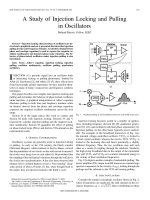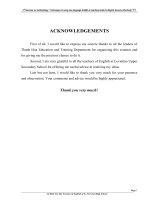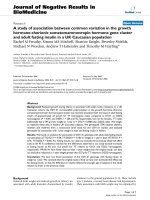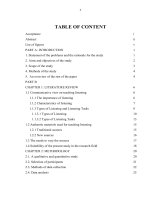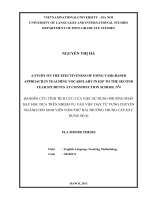A STUDY OF USING AUTHENTIC SUPPLEMENTARY TASKS IN TEACHING SPEAKING TO 10 GRADE STUDENTS AT DOAN THUONG UPPER-SECONDARY SCHOOL, HAI DUONG PROVINCE
Bạn đang xem bản rút gọn của tài liệu. Xem và tải ngay bản đầy đủ của tài liệu tại đây (1.43 MB, 67 trang )
VIETNAM NATIONAL UNIVERSITY, HANOI
UNIVERSITY OF LANGUAGES AND INTERNATIONAL STUDIES
FACULTY OF POST-GRADUATE STUDIES
VŨ THỊ QUYÊN
A STUDY OF USING AUTHENTIC SUPPLEMENTARY
TASKS IN TEACHING SPEAKING TO 10 GRADE
STUDENTS AT DOAN THUONG UPPER-SECONDARY
SCHOOL, HAI DUONG PROVINCE
NGHIÊN CỨU VIỆC SỬ DỤNG NHIỆM VỤ BỔ TRỢ XÁC
THỰC ĐỂ DẠY KỸ NĂNG NÓI CHO HỌC SINH LỚP 10
TRƯỜNG THPT ĐOÀN THƯỢNG, HẢI DƯƠNG
M.A. MINOR THESIS
FIELD: ENGLISH TEACHING METHODOLOGY
CODE: 601410
HANOI, 2012
VIETNAM NATIONAL UNIVERSITY, HANOI
UNIVERSITY OF LANGUAGES AND INTERNATIONAL STUDIES
FACULTY OF POST-GRADUATE STUDIES
VŨ THỊ QUYÊN
A STUDY OF USING AUTHENTIC SUPPLEMENTARY
TASKS IN TEACHING SPEAKING TO 10 GRADE
STUDENTS AT DOAN THUONG UPPER-SECONDARY
SCHOOL, HAI DUONG PROVINCE
NGHIÊN CỨU VIỆC SỬ DỤNG NHIỆM VỤ BỔ TRỢ XÁC
THỰC ĐỂ DẠY KỸ NĂNG NÓI CHO HỌC SINH LỚP 10
TRƯỜNG THPT ĐOÀN THƯỢNG, HẢI DƯƠNG
M.A. MINOR THESIS
FIELD: ENGLISH TEACHING METHODOLOGY
CODE: 601410
SUPERVISOR: ĐỖ BÁ QUÝ, M.Ed.
HANOI, 2012
iv
TABLE OF CONTENTS
page
Declaration
i
Acknowledgements
ii
Abstract
iii
Table of contents
iv
List of abbreviations
vi
List of tables, charts and figures
vii
PART A: INTRODUCTION
1
1. Rationale of the study
1
2. Aims and objectives of the study
2
3. Scope of the study
3
4. Methods of the study
3
5. Design of the study
4
PART B: DEVELOPMENT
5
CHAPTER 1: LITERATURE REVIEW
5
1.1. An overview of Task-based Language Teaching
5
1.1.1. Definition of a task
5
1.1.2. Task components
6
1.1.3. Types of tasks
6
1.2. An overview of supplementation
9
1.3. Speaking skill
10
1.4. Authentic tasks in speaking
11
1.4.1. Definition of authentic tasks
11
1.4.2. Levels of authentic tasks
12
1.4.3. The means of achieving authenticity
14
1.5. Overview of related studies
15
v
1.6. Summary of the chapter
16
CHAPTER 2: METHODOLOGY
17
2.1. Participants
17
2.1.1. Overview of Doan Thuong Upper-secondary School
17
2.1.2. The context of teaching and learning English speaking skill in DTUS
17
2.1.3. The teacher informants
18
2.1.4. The student informants
18
2.2. Data collection instruments
18
2.2.1. Questionnaire
18
2.2.2. Classroom observation
19
2.3. Data collection procedure
22
2.4. Data analysis methods and procedure
23
CHAPTER 3: DATA ANALYSIS AND DISCUSSION
24
3.1. Research question 1: What are the teachers’ perceptions of attitudes
towards using AST in teaching speaking to 10 grade students?
24
3.1. Research question 2: What are the students’ attitudes towards the
effects of AST on their speaking lessons?
32
3.3. Summary of the chapter
35
PART C: CONCLUSION
36
1. Summary of the findings
36
2. Pedagogical implications
37
3. Limitations of the study
39
4. Suggestions for further studies
40
REFERENCES
41
APPENDICES
I
Appendix 1 : Survey Questionnaire for Teachers
I
Appendix 2 : Survey Questionnaire for Students
V
Appendix 3 : Classroom Observation Checklists
VII
vi
LIST OF ABBREVIATIONS
- AST : Authentic Supplementary Tasks
- CLT : Communicative Language Teaching
- DTUS : Doan Thuong Upper-secondary School
- TEFL : Teaching English as a Foreign Language
vii
LIST OF TABLES, CHARTS AND FIGURES
Page
List of tables
Table 1 : Task components‟ classifications
Table 2 : Task components according to Nunan (2004)
Table 3 : Basic profiles of six teacher informants
Table 4 : Basic profiles of student informants
Table 5: Teacher‟s attitudes towards teaching speaking and using
authentic tasks in teaching speaking in general
Table 6: The stage of the lesson that teachers preferred to use
authentic tasks
Table 7: The work distribution that teachers preferred when using
authentic tasks
Table 8: The advantages and disadvantages of AST as perceived by
the students
Table 9: Results from open-ended questions
7
7
18
19
26
30
30
33
35
List of charts and figures
Chart 1: Teachers‟ perceptions of the importance of authentic tasks in
TEFL
24
Chart 2: Teachers‟ identifying of authentic and pedagogical tasks
25
Chart 3: Teachers‟ attitudes towards authentic tasks‟ advantages
28
Chart 4: Teachers‟ attitudes towards authentic tasks‟ disadvantages
29
Chart 5: Teacher‟s frequency of using authentic tasks
29
Chart 6: Students‟ responses as perceived by the teachers
31
viii
Chart 7: Teachers‟ difficulties in exploiting AST
Chart 8: Students‟ attitudes towards AST‟s effects
Chart 9: Students‟ opinions towards teachers‟ applied AST
31
32
34
Figure 1: A frame work for Task-based Language Teaching
8
Figure 2: The relation among four language skills
Figure 3: Comparison between Brown and Menasche‟s levels of
authentic tasks and Nunan‟s classification of tasks
10
13
1
PART A: INTRODUCTION
1. Rationale of the study
Nowadays, English has increasingly become one of the most popular
languages with more than one billion speakers all over the world. English is playing
a key role in today‟s modern world because it is used as an international language in
many areas such as: science and technology, business and commerce, international
relations and diplomacy, etc. Therefore, “Teaching and Learning Foreign
Languages in the national education system for the period 2008 - 2020” project
was launched and carried out. Its goals are by 2020 : “making the majority of
Vietnamese youth ( ) have enough foreign language capability to use
independently, be self-confident in communication and learning, work in an
environment of integration, multi-language and multi-culture; making foreign
languages (mainly English) become the strength of Vietnamese people and
contributing to the industrialization and modernization of the country”. The long–
term plan set up an urgent requirement for foreign language teachers, in general,
and English teachers, in particular to innovate and “learn the newest and best
methods of teaching” (Hiệp, 2005, p. 3). Another aims are to teach learners a
working command of English to satisfy various communicative needs in their life
and to build a friendly school with students‟ active learning (Hiệp, 2005).
Fortunately, according to Hiệp (2005), since the early 1990s, Communicative
Language Teaching (CLT) has widely spread out for the fact that, in comparison
with traditional pedagogy -which is based on language study (grammar, literature)
and written exercises (translation) rather than real life communication and speech, it
meets the requirements of English learning in an era of integration and
globalization. However, in the context of Vietnam education, it is lack of
motivation from learning environment or even from the textbook that actuates
Vietnamese learners to communicate successfully in English. Therefore, it is
necessary for English teachers to not only adapt the textbook but also apply
authentic materials. These, with appropriate selection and implementation, can be
2
reliable sources for designing tasks in which formulaic language learning can be
avoided, and can provide a bridge between the linguistic skills of learners and their
ability to take part in native-like real world activity (Valeriu, 2000).
Recognizing the gap, many researchers, both worldwide and in Vietnam,
have analyzed the term “authenticity” in teaching Reading, Writing and Listening.
However, the number of researched Speaking Authenticity ones is still limited
while, thirty-five percent of our daily communication time is spent on speaking
(Burely-Allen, 1995). Therefore, the exploitation of authentic speaking tasks should
receive worthy attention.
Within the context of DTUS, Hai Duong province – a rural area school, students
have few chances to use English in their daily life. The teachers pay much attention to
grammar while student‟s proficiency is even not enough to master some particular
tasks in the textbook. From my point of view, among four skills, speaking is the least
preferred by students due to students‟ low level and the disparity between the textbook
and students‟ needs. Therefore, it requires some supplementation for the textbook to
gradually upgrade the students‟ level as well as to motivate them to actively participate
in English lessons, especially speaking ones.
From the reasons mentioned above, the researcher finds her duty in
conducting the study on “A Study of Using Authentic Supplementary Tasks in
Teaching Speaking to 10 Grade Students at Doan Thuong Upper-Secondary School,
Hai Duong Province”
2. Aims and objectives of the study
The study aims at searching Doan Thuong Upper-Secondary School tenth
grade teachers and students‟ attitudes toward exploiting authentic supplementary
tasks in speaking lessons. To teachers, the researcher closely focuses on their
perception of authentic tasks, using authentic supplementary tasks in speaking skill
as well as the difficulties they encounter when carrying out the tasks. To learners,
concentration is put in another aspect: their perception of the effects of the authentic
3
supplementary tasks on their speaking lessons. To realize these aims, the answers to
the following questions are sought:
1. What are the teachers‟ perceptions of and attitudes towards using authentic
speaking supplementary tasks in teaching speaking to 10 grade students?
2. What are the students‟ attitudes towards the effects of the authentic
supplementary tasks on their speaking lessons?
3. Scope of the study
Initially, the study only covers the tenth form teachers and students at DTUS.
With a large number of participants as well as the variety of students‟ level, these
samples can be considered an appropriate reflection of DTUS‟ teachers and
students‟ language competence.
Secondly, “the authentic speaking tasks” term of the study belongs to the
supplementary term which does not contain the designed tasks in the textbook.
Therefore, the evaluation of the textbook in terms of authenticity is not included in
the study. Only the teachers and students‟ beliefs and attitudes towards the term are
presented.
Finally, the “speaking tasks” mentioned in the thesis only means the
activities that teachers and students carry out in the speaking periods (according to
the course distribution). Any further tasks, for examples, in reading or listening
lessons, are beyond the scope of this study.
4. Methods of the study
To reach the aims of the study, both qualitative and quantitative approaches
are made used of. Data are collected from questionnaires and classroom
observation. The quantitative data collected from survey questionnaire were then
analyzed statistically, while qualitative data were obtained from classroom
observation. Hopefully, with the combination of these methods, the study would
yield reliable and valid findings.
5. Design of the study
The thesis consists of three main parts:
4
The Introduction presents an overview of the study including the rationale,
aims, research questions, scope, methods and design of the study.
The Development is the backbone of the thesis which includes three
chapters. Chapter one supplies readers with the explanation of key conceptual
terms, the definitions, the contrasting views and debates as well as the critical
analysis of each key concept. Chapter two outlines the research methods used and
demonstrates that recognized procedures have been followed in the study.
Participants, data collection instruments, procedures of data collection and data
analysis methods and procedures would be included. Chapter three presents the
results collected from two instruments above in an objective way according to two
research questions. Then, the discussion or the interpretation from the resulted
would be presented.
The Conclusions contains the summary of the main findings of the thesis, its
limitation, suggestions for further studies and some pedagogical implications for
teachers.
5
PART B: DEVELOPMENT
CHAPTER 1: LITERATURE REVIEW
This chapter acts as the theoretical foundation for the whole study in which
key concepts find out their references. In addition, an overview of related studies at
the same level, which supports the researcher to carry out the study, is also included.
1.1. An overview of Task-based Language Teaching
1.1.1. Definition of a task
It can be emphatically asserted that a full and acute awareness of the term
“task” appears almost essential to get a close and deep look at the theory of
“authentic task”. Since CLT approach became an innovative approach in language
teaching, task-based language teaching consolidates its central position; therefore, it
raises an urgent question for researches to find out what does “task” means. As a
consequence, a variety of “task” definitions were established, among them is
Willis‟s (1996, p.23) one: “Tasks are activities where the target language is used
by learners for communicative purpose (goal) in order to achieve an outcome”
which, as commented by Nunan (2004), emphasizes the exchange of meaning, in a
communicative way, as the means of mastering target language. Another worth-
mentioning one is defined by Long (1985, p.89): “A task is a piece of work
undertaken for oneself or for others, freely or for some reward. In other words, by
“task” is meant the hundred and one things people do in everyday life, at work, at
play and in between.”
Compared with Willis‟s definition, Long‟s one is distinctly different. It, in
short, is “non-technical and non-linguistic” (Nunan, 2004, p.2), in which language
uses can be omitted (helping someone across without talking). Thus, it requires
drawing a distinction between the “uses of language in the world beyond the
classroom” and “those that occur in the classroom”, which is named “real-world
tasks/ target tasks” and “pedagogical tasks” (Nunan, 2004, p.1). For the fact that the
transformation from a target task to a pedagogical one happens naturally and
6
simultaneously with its movement from real world into the classroom, pedagogical
tasks appears to be the only focus of this study.
It, then, comes the definition of Nunan which, from my limited personal
viewpoint, can deal with almost ambiguity in defining “task”, shorten other above-
mentioned definitions‟ shortcomings, set up the criteria of a pedagogical task,
particularize learners‟ duties in exploiting the target language and appreciate the
role of meaning in language learning. Therefore, whenever the term “task” is
mentioned in this paper, it refers to Nunan‟s definition.
“A task is a piece of classroom work that involves learners in
comprehending, manipulating, producing or interacting in the target
language while their attention is focused on mobilizing their grammatical
knowledge in order to express meaning, and in which the intention is to
convey meaning rather than to manipulate form. “
(Nunan, 2004, p.4)
1.1.2. Task components
Besides seeking the appropriate answer for the question of what a task means,
it is also important to put a certain concentration on task components. Actually,
many researchers pay rapt attention to give out logical task structures, some of
which are succinctly summarized in the table below:
Nunan (2004, p.41)
6 components:
Goals
Input
Activities
Teacher role
Learner role
Settings
Estaire and Zanón
(1994, p.14)
4 components
A specified working procedure
Appropriate materials (if necessary)
A concrete language learning purpose
A concrete learning outcome
Wright (1987, p.47)
2 components
Input data
Initiating question
7
Candlin (1987)
7 components
Input
Roles
Settings
Actions
Monitoring
Outcomes
Feedback
Shavelson and Stern (1981)
6 elements
Content
Materials
Activities
Goals
Students
Social community
Table 1: Task components’ classifications
From the above table, although different ways were given to sub-divide tasks,
they share something in common. To some extents, the author‟s way of division
overlaps, covers or concretizes others‟ theories. Nevertheless, within the scope of
this study, I follow the task structure of Nunan, which is closely related to other key
concepts of my study as well as probably further the working of the study. It is,
consequently, important to bring out the definition of each component.
TASK
GOALS
The vague general intentions behind any given learning
task in which teacher might find the answer for the
question: “Why did you get learners to engage in Task X?”
INPUT
The data that form the point of departure for the task
ACTIVITIES
What learners will actually do with the input
TEACHER ROLE
The part that learners and teachers are expected to play
in carrying out learning tasks as well as the social and
interpersonal relationship between the participants
LEARNER ROLE
SETTING
Classroom arrangements specified or implied in the task
Table 2: Task components according to Nunan (2004)
1.1.3. Types of tasks
There exists a variety of ways to classify task basing on different categories.
Nunan‟s classification in which task is divided into two main types “Real
8
world/target task” and “Pedagogical task” is the most suitable to represent the types
of task used in this study. Moreover, the frame work that Nunan presented in “Task-
based Language Teaching” also reinforces the knowledge for the research.
Figure 1: A frame work for Task- based language teaching
(Nunan, 2004, p. 25)
Real-world or target task: A communicative act we achieve through
language in the world outside the classroom.
Pedagogical tasks: A piece of classroom work which involves learners in
comprehending, manipulating, producing or interacting in the language while their
attention is principally focused on meaning rather than forms. They have a non-
linguistic outcome, and can be divided into rehearsal tasks or activation tasks.
Rehearsal task: A piece of classroom work in which learners rehearse, in
class, a communicative act they will carry out outside the class.
Activation task: A piece of classroom work involving communicative
interaction, but NOT one in which learners will be rehearsing for some out-of-class
communication. Rather they are designed to activate the acquisition process.
Enabling skills: Mastery of language systems grammar, pronunciation,
vocabulary, etc. which ENABLE learners to take part in communicative tasks.
Language exercise: A piece of classroom work focusing learners on, and
involving learners in manipulating some aspect of the linguistic system
Pedagogical tasks
Real world/ target tasks
Rehearsal
tasks
Activation
tasks
Communicative
activities
Language
exercises
Enabling skills
9
Communication activity: A piece of classroom work involving a focus on a
particular linguistic feature but ALSO involving the genuine exchange of meaning.
1.2. An overview of supplementation
As it can be obviously seen from the literal meanings of the two words
“Supplementary” and “Materials”, which, according to Oxford Advanced Learners
Dictionary 7
th
Editor, respectively mean “provided in addition to something else in
order to improve or complete it” and “things that are needed in order to do a
particular activity”, Supplementary materials can be understood as “Materials
designed to be used in addition to the core materials of a course or the course book
by the teachers” (Hương & Minh (2008, p28). Naturally, supplementary materials
are not the replacement of the coursebook.
Supplementary materials are not merely meant “adding something new”, but
definitely to “bridge the gap between a coursebook and the demands of a public
examination, or the coursebook and students‟ needs” (McGrath, 2005, p.80)
McGrath (2005) suggested two ways to supplement a course book:
1. by utilizing items, such as exercises, texts or activities from another
published sources
2. by devising our own materials; this may include the exploitation of
authentic, visual or textual items
When using published materials, teachers often photocopy the necessary
tasks or exercises which tend to be expensive and sometimes frustrating (when there
is something wrong with the machine or students lose the pieces of paper or forget
to bring them to class). However, all reference books are cautiously edited by a
group of qualified people. According to McGrath (2005), 50 per cent of teachers
claimed not to use commercially-produced materials at all. Instead, they choose to
prepare their own supplementary materials which can satisfy them when “the course
book does not fully meet the specific needs of the learner group” or “no suitable
published materials are available (or these cannot be copied or bought)”.
10
1. 3. Speaking skill
When talking about language and language teaching, people cannot help
mentioning the four skills: Reading, Listening (Understanding), Speaking and
Writing as well as the relation among them. Speaking skill, along with writing skill,
is considered as productive skills. The other two are receptive skills.
Listening
Speaking
Reading
Writing
Figure 2: The relation among four language skills
According to Byrne (1976, p.8), speaking is “a two-way process between
speaker and listener, involving the productive skill of speaking and receptive skill of
understanding”. Both listener and speaker have a positive function to perform: the
speaker has to encode the message to be conveyed in appropriate language, while
the listener has to decode the message.
Hương & Minh (2008) also explain speaking as the act “to utter words with
the ordinary voice/talk, to express or communicate ideas, options by talking”. As a
result, there are numbers of abilities underlying speaking proficiency: lexical and
grammar, compensating language, connected speech, language processing,
expressive devices and social linguistic knowledge. Hương & Minh (2008, p.170)
Lexis and grammar: the use of a number of common lexical, especially to
perform certain language functions such as greeting, disagreeing, approval, etc.
Connected speech: common phenomenon in spoken interaction in which sounds
are modified, omitted, added or weakened. Effective speakers thus need to be able
to not only produce individual phonemes but also use connected speech.
Expressive language: native speaker of English change pitch and stress of
particular parts of utterances, vary volume and speech can convey meanings beyond
their words, especially in face-to-face communication. Students need to recognize
Receptive
Skills
Productive
Skills
Written language
Spoken language


